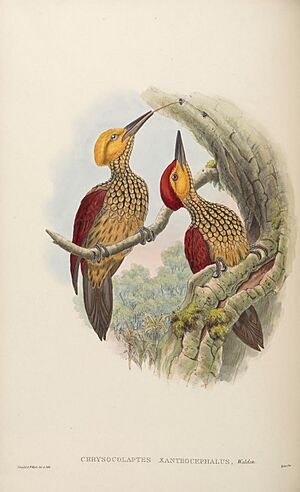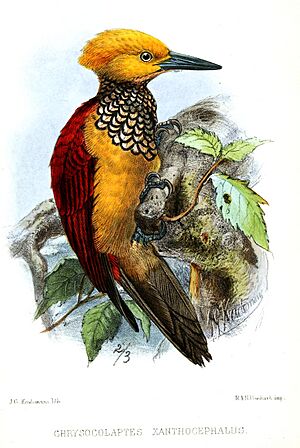Yellow-faced flameback facts for kids
Quick facts for kids Yellow-faced flameback |
|
|---|---|
 |
|
| An illustration of a female (left) and a male (right) Yellow-faced flameback | |
| Conservation status | |
| Scientific classification | |
| Genus: |
Chrysocolaptes
|
| Species: |
xanthocephalus
|
The yellow-faced flameback (Chrysocolaptes xanthocephalus) is a beautiful type of bird that belongs to the woodpecker family. It's known for its bright yellow head and striking red back. You can find this special bird on the Philippine islands of Negros and Panay. Sadly, it used to live on Guimaras, Masbate, and Ticao, but it's not there anymore. This flameback is one of the rarest woodpeckers in the Philippines. It is in danger because it is losing its home.
Contents
What Does the Yellow-faced Flameback Look Like?
The yellow-faced flameback is a large woodpecker. It lives in lowland forests in the central Philippines. This bird has a red back and a black tail. Its belly and cheeks are yellow. It also has a black neck with big white spots.
You can tell male and female flamebacks apart by their crests. Males have a bright red crest on their head. Females have a yellow crest. This difference between males and females is called sexual dimorphism. The bird makes loud, ringing calls that sound like "geek-geek-geek!"
Where Does the Yellow-faced Flameback Live?
This special bird lives in different kinds of forests. It can be found in old, untouched forests. It also lives in newer forests that are growing back. Sometimes, it even lives near mango farms or human homes. The highest place it has been seen is about 900 meters up a mountain called Kanlaon on Negros Island. It seems to prefer living in forests closer to sea level. These birds usually have their babies between February and August.
Why is the Yellow-faced Flameback in Danger?
The yellow-faced flameback is an endangered species. This means it is at a very high risk of disappearing forever. Scientists believe there are only about 250 to 999 adult birds left. The biggest problem for these birds is habitat loss. This means their forest homes are being destroyed.
- Forests are disappearing: A lot of the original forests on Negros and Panay islands are gone. In 1988, only 4% of the forests were left on Negros. On Panay, only 8% remained.
- Homes are shrinking: People are cutting down trees for farms, wood, and charcoal. This keeps destroying the remaining small parts of the forest.
- Less lowland forest: The lowland forests, which these birds love, are becoming very small. There might not be any suitable forest left on Guimaras, Masbate, and Ticao islands.
How Can We Help the Yellow-faced Flameback?
Experts suggest several ways to help save this rare woodpecker:
- Study the birds: We need to find out how many birds are left. We also need to know exactly where they live.
- Plant more trees: We should plant trees around the forests that are still there. This helps make their homes bigger and safer.
- Stop illegal logging: Laws need to be enforced to stop people from illegally cutting down trees. Even small amounts of illegal logging hurt the birds.



